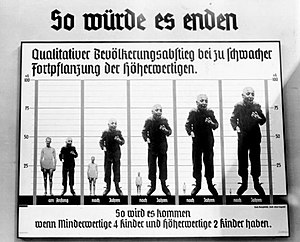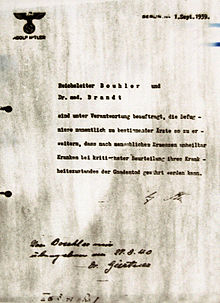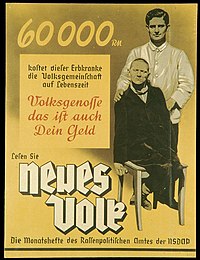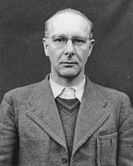
Eugenics is a set of beliefs and practices that aim to improve the genetic quality of a human population. Historically, eugenicists have attempted to alter human gene pools by excluding people and groups judged to be inferior or promoting those judged to be superior. In recent years, the term has seen a revival in bioethical discussions on the usage of new technologies such as CRISPR and genetic screening, with heated debate around whether these technologies should be considered eugenics or not.

Karl Brandt was a German physician and Schutzstaffel (SS) officer in Nazi Germany. Trained in surgery, Brandt joined the Nazi Party in 1932 and became Adolf Hitler's escort doctor in August 1934. A member of Hitler's inner circle at the Berghof, he was selected by Philipp Bouhler, the head of Hitler's Chancellery, to administer the Aktion T4 euthanasia program. Brandt was later appointed the Reich Commissioner of Sanitation and Health. Accused of involvement in human experimentation and other war crimes, Brandt was indicted in late 1946 and faced trial before a U.S. military tribunal along with 22 others in United States of America v. Karl Brandt, et al. He was convicted, sentenced to death, and hanged on 2 June 1948.
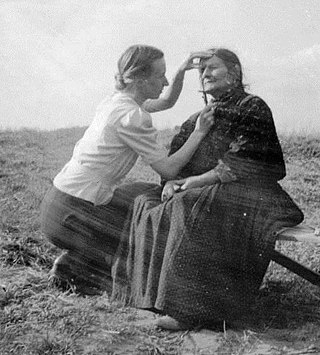
The racial policy of Nazi Germany was a set of policies and laws implemented in Nazi Germany under the dictatorship of Adolf Hitler, based on pseudoscientific and racist doctrines asserting the superiority of the putative "Aryan race", which claimed scientific legitimacy. This was combined with a eugenics program that aimed for "racial hygiene" by compulsory sterilization and extermination of those who they saw as Untermenschen ("sub-humans"), which culminated in the Holocaust.

Aktion T4 was a campaign of mass murder by involuntary euthanasia in Nazi Germany. The term was first used in post-war trials against doctors who had been involved in the killings. The name T4 is an abbreviation of Tiergartenstraße 4, a street address of the Chancellery department set up in early 1940, in the Berlin borough of Tiergarten, which recruited and paid personnel associated with Aktion T4. Certain German physicians were authorised to select patients "deemed incurably sick, after most critical medical examination" and then administer to them a "mercy death". In October 1939, Adolf Hitler signed a "euthanasia note", backdated to 1 September 1939, which authorised his physician Karl Brandt and Reichsleiter Philipp Bouhler to begin the killing.

Eugen Fischer was a German professor of medicine, anthropology, and eugenics, and a member of the Nazi Party. He served as director of the Kaiser Wilhelm Institute of Anthropology, Human Heredity, and Eugenics, and also served as rector of the Frederick William University of Berlin.
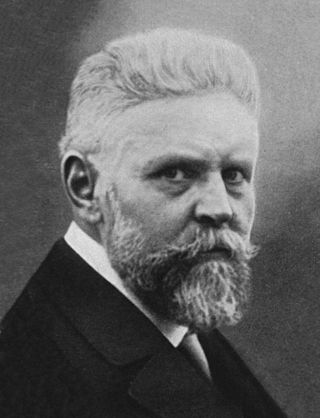
The term racial hygiene was used to describe an approach to eugenics in the early 20th century, which found its most extensive implementation in Nazi Germany. It was marked by efforts to avoid miscegenation, analogous to an animal breeder seeking purebred animals. This was often motivated by the belief in the existence of a racial hierarchy and the related fear that "lower races" would "contaminate" a "higher" one. As with most eugenicists at the time, racial hygienists believed that the lack of eugenics would lead to rapid social degeneration, the decline of civilization by the spread of inferior characteristics.

Viktor Hermann Brack was a member of the Schutzstaffel (SS) and a convicted Nazi war criminal and one of the prominent organisers of the involuntary euthanasia programme Aktion T4; this Nazi initiative resulted in the systematic murder of 275,000 to 300,000 disabled people. He held various positions of responsibility in Hitler's Chancellery in Berlin. Following his role in the T4 programme, Brack was one of the men identified as responsible for the gassing of Jews in extermination camps, having conferred with Odilo Globočnik about its use in the practical implementation of the Final Solution. Brack was sentenced to death in 1947 in the Doctors' Trial and executed by hanging in 1948.

Ernst Rüdin was a Swiss-born German psychiatrist, geneticist, eugenicist and Nazi, rising to prominence under Emil Kraepelin and assuming the directorship at the German Institute for Psychiatric Research in Munich. While he has been credited as a pioneer of psychiatric inheritance studies, he also argued for, designed, justified and funded the mass sterilization and clinical killing of adults and children.

Alfred Ploetz was a German physician, biologist, Social Darwinist, and eugenicist known for coining the term racial hygiene (Rassenhygiene), a form of eugenics, and for promoting the concept in Germany.

The Hadamar killing centre was a killing facility involved in the Nazi involuntary euthanasia programme known as Aktion T4. It was housed within a psychiatric hospital located in the German town of Hadamar, near Limburg in Hessen.
Fritz Gottlieb Karl Lenz was a German geneticist, member of the Nazi Party, and influential specialist in eugenics in Nazi Germany.

The German Society for Racial Hygiene was a German eugenic organization founded on 22 June 1905 by the physician Alfred Ploetz in Berlin. Its goal was "for society to return to a healthy and blooming, strong and beautiful life" as Ploetz put it. The Nordic race was supposed to regain its "purity" through selective reproduction and sterilization. The society became defunct after World War II.
Law for the Prevention of Genetically Diseased Offspring or "Sterilisation Law" was a statute in Nazi Germany enacted on July 14, 1933, which allowed the compulsory sterilisation of any citizen who in the opinion of a "Genetic Health Court" suffered from a list of alleged genetic disorders – many of which were not, in fact, genetic. The elaborate interpretive commentary on the law was written by three dominant figures in the racial hygiene movement: Ernst Rüdin, Arthur Gütt and the lawyer Falk Ruttke.

The Hereditary Health Court, also known as the Genetic Health Court, was a court that decided whether people should be forcibly sterilized in Nazi Germany. That method of using courts to make decisions on hereditary health in Nazi Germany was created to implement the Nazi race policy aiming for racial hygiene.

Eugenics, the set of beliefs and practices which aims at improving the genetic quality of the human population, played a significant role in the history and culture of the United States from the late 19th century into the mid-20th century. The cause became increasingly promoted by intellectuals of the Progressive Era.
Child Euthanasia was the name given to the organized killing of severely mentally and physically disabled children and young people up to 16 years old during the Nazi era in over 30 so-called special children's wards. At least 5,000 children were victims of the program, which was a precursor to the subsequent murder of children in the concentration camps.
The history of eugenics is the study of development and advocacy of ideas related to eugenics around the world. Early eugenic ideas were discussed in Ancient Greece and Rome. The height of the modern eugenics movement came in the late 19th and early 20th centuries.

Friedrich Wilhelm Schallmayer was Germany's first advocate of eugenics who, along with Alfred Ploetz, founded the German eugenics movement. Schallmayer made a lasting impact on the eugenics movement.

Racial Hygiene: Medicine Under the Nazis is a non-fiction book by American historian Robert N. Proctor, published in 1988 by Harvard University Press. The author explores the German scientific community's role in forming and implementing the racial policies of Nazi Germany. In his study, Proctor analyzes how Nationalsozialistische Rassenhygiene, National Socialist racial hygiene or “Eugenics” was used to justify racial programs and traces the progression of eugenic methods, such as involuntary euthanasia, within Germany. Racial Hygiene generally received positive reviews for its analysis of medical practitioners’ complicity in Nazi racial doctrine.
